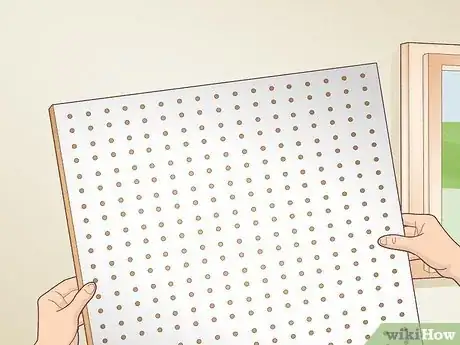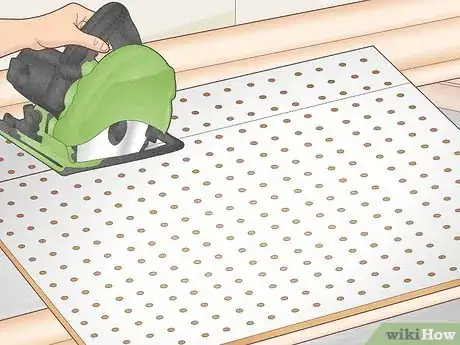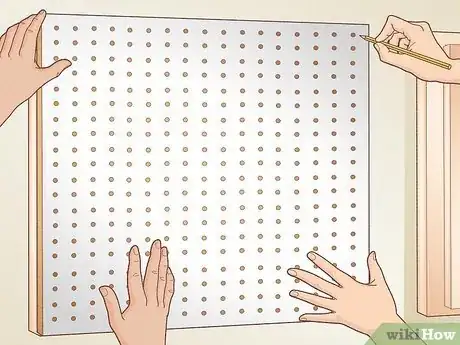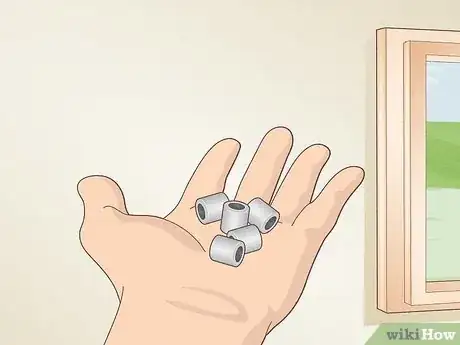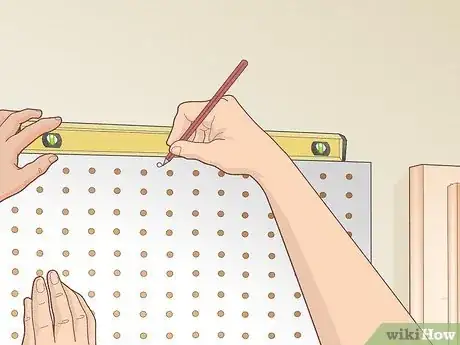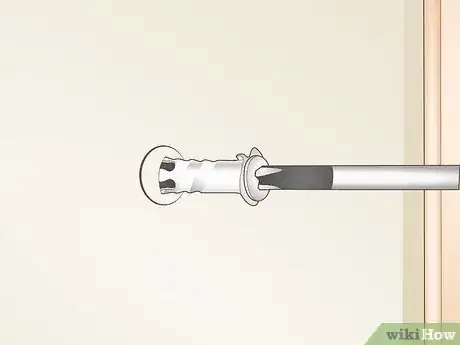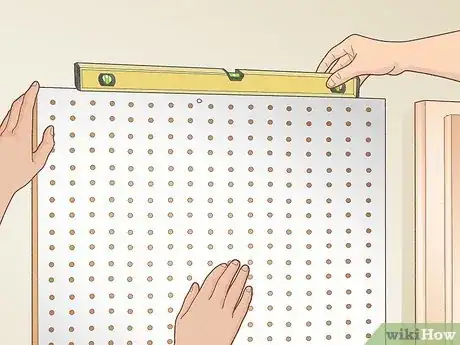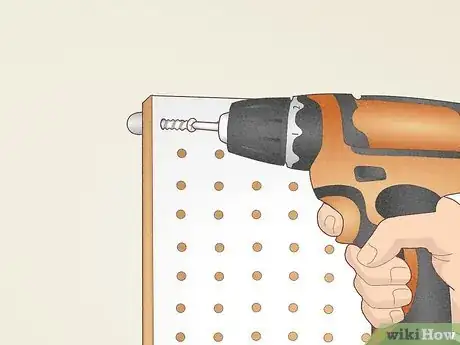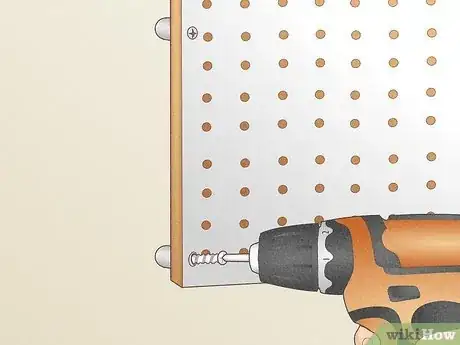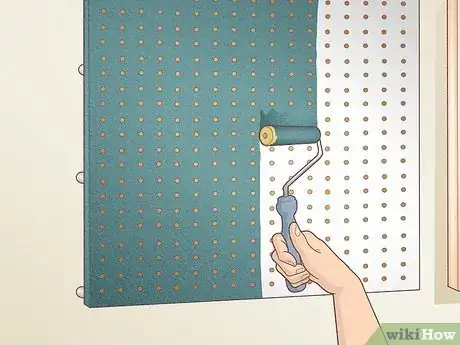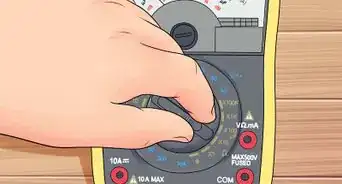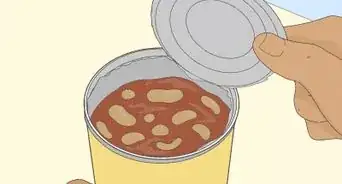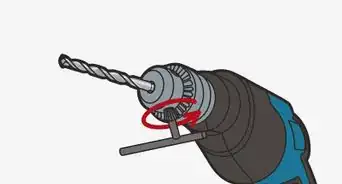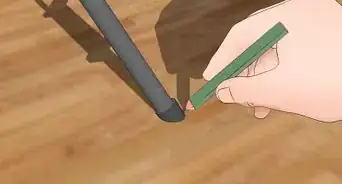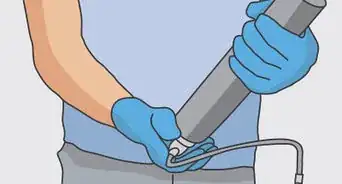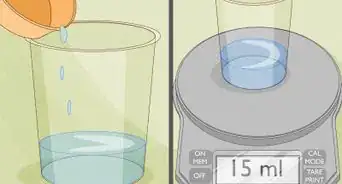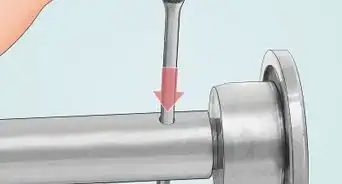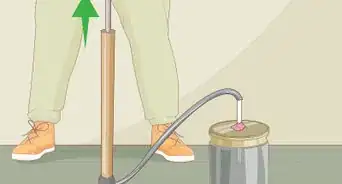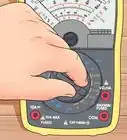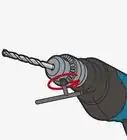This article was co-authored by Patrick Johns and by wikiHow staff writer, Eric McClure. Patrick Johns is a Home Improvement Specialist and the Owner of CatchAll Handyman Services. With more than 28 years of experience, he has worked on a variety of home improvement projects, such as carpentry, plumbing, and door and window installations in both commercial and residential properties.
There are 13 references cited in this article, which can be found at the bottom of the page.
wikiHow marks an article as reader-approved once it receives enough positive feedback. In this case, 100% of readers who voted found the article helpful, earning it our reader-approved status.
This article has been viewed 277,465 times.
Need some extra storage space in your garage, office, or kitchen? Pegboards are a slick, elegant solution! Mounting a pegboard may seem like a daunting task, but it’s actually pretty easy. The main question is whether you use furring strips to build a frame for the board, or use spacers to mount it. Worry not, we’ll cover both options! In this article, we’ll walk you through everything you need to know about installing pegboard.
Steps
Measuring and Gathering Materials
-
1Use a measuring tape to determine where you’ll hang your pegboard. Measure the length and height you’d like to cover and jot this measurement down. You can cut a board to size, but it’s probably easier to just buy smaller boards and hang them next to one another or buy a single board that’s close to the space you want to cover.[1]
-
2Buy a pegboard based on your storage needs and preferences. Use your measurements to purchase a pegboard that matches the space. Pegboards come in a variety of different colors and styles, so choose one that you find aesthetically pleasing—especially if you’re hanging it indoors.[2]
- Metal pegboards are heavier, but they’re more durable than the typical wood or plastic.
- Wood and plastic boards are lighter and they tend to have a warmer feel if you’re installing the board indoors.
- You can always paint a pegboard if you don’t like the way it looks, so don’t worry a ton about the color if you have a specific look in mind and you’re feeling crafty.
Advertisement -
3Cut your pegboard to size with a circular saw (optional). If you do want to cut a pegboard to size, flip it upside down on top of two sawhorses. Put on eye protection and gloves, and use a straight edge to mark your cut. Turn a circular saw on and gently guide it through the line you drew to cut it to size.[3]
- You can use a jigsaw instead of a circular saw if you prefer.
- If you have an especially thin wood or plastic pegboard, you can use a sharp utility knife to score the board and then snap it off by hand.
Installing Furring Strips
-
1Purchase furring strips that match the dimensions of your pegboard. If your pegboard didn’t come with spacers or you want to hang especially heavy items on your pegboard, purchase furring strips. These are 1 by 2 in (2.5 by 5.1 cm) wood boards you can buy at any home improvement store.[4]
- You are going to screw the furring strips into the wall and then hang the pegboard on the furring strips. This will provide additional support and ensure there’s a gap between the board and the wall for your hooks to slide through.
- You can cut furring strips to size with a handsaw, jigsaw, or circular saw.
- The number of furring strips you need depends on the size of the pegboard. For a board that’s roughly 3 by 3 feet (0.91 by 0.91 m) or so, create a square-shaped frame for the edges of your board.
-
2Use a stud finder to identify and mark the studs you’re going to use. On the wall where you’re going to hang the pegboard, run a stud finder along the wall. Use a pencil to mark every stud that along the horizontal length of the wall that the pegboard will cover.[5]
- Studs are typically spaced out every 12 inches (30 cm) or 16 inches (41 cm).
-
3Drill your furring strips into the wall using 3 in (7.6 cm) wood screws. Once you have the studs marked, hold your first furring strip up on the wall where the top horizontal edge of the pegboard will go. Use a spirit level to make sure the strip is straight and drill it into the studs with 3 inches (7.6 cm) wood screws. Repeat this process for the rest of your furring strips.[6]
- Only hang vertical furring strips on studs.
- You can install as many furring strips as you’d like. You typically don’t need more than two (top and bottom edge) for smaller pegboards. For larger pegboards, you might place one furring strip every 1 ft (0.30 m) or so.
-
4Hang your board over the strips and mark the screws you’re going to use. Have a friend help you lift the board up on to the furring strips. Use a spirit level to make sure it’s even on top of your furring strips. Then, use a pencil to outline the screw slots you plan on using on your furring strips. You can use any number of screws you like, but aim to place one screw every 8–16 inches (20–41 cm) or so.[7]
- If there are instructions that came with your pegboard regarding how far apart your screws should be, follow those instead.
- Mark screw slots on every single furring strip you mounted.
Using Spacers
-
1Purchase spacers for your screws if they didn’t come with the board. Most pegboards come with spacers to maintain a gap between the wall and the peg board—which is essential since the hooks you use to hang things stick out behind the board. If your pegboard didn’t come with spacers, swing by a home improvement store and purchase spacers.[8]
- There are spacers designed specifically for pegboard that make this process easy.[9] You can pick them at any home improvement store.
- If possible, buy adhesive spacers. This way, you can install the spacers over the screw slots you marked ahead of time so you don’t need to fiddle around in the small space between the wall and the pegboard.[10]
-
2Attach the spacers ahead of time if they’re adhesive. If you have adhesive spacers, simply peel the backing off and press them over each circle you’ve outlined on your wall (or over each wall anchor where applicable). Don’t worry about the spacers not being hyper secure. The tension from the board and the screws will keep the spacers in place.[11]
- If you don’t have adhesive spacers, you’ll need to have a friend hold the board up while you slide the spacer in between the pegboard and the wall so that it lines up with the slot. Then, drive the screw through the gap in the pegboard and the spacer.
-
3Mark the slots for your screws by holding the pegboard against the wall. Have a friend help you with this one. Lift the board up together against the wall where you want to hang it. Use a spirit level to make sure that the edges are all straight on the wall. Once everything is even, use a pencil to draw a circle inside of each screw slot where you’d like to drive a support screw.[12]
- If the pegboard came with spacers, there should be instructions on where you need to install support screws.
- If there are no instructions, mark one circle every 8–16 inches (20–41 cm) around the edges of the board.
-
4Install wall anchors anywhere where you aren’t drilling into a stud. Unless you’re hanging super heavy power tools, you don’t actually need to hang the board on studs so long as you use wall anchors. Use a stud finder to identify if your screw slots line up with the studs. If they do, skip the anchor. For screw slots that are in hollow drywall, drill a pilot hole and screw a drywall anchor in the wall.[13]
- Do not use toggle bolts. The pegboard is likely going to tear the drywall out if you use toggle bolts.[14]
Mounting Your Pegboard
-
1Enlist a friend to lift the pegboard up and make sure it’s level. This requires at least one other person, but two would make it even easier. Check to make sure that the screw slots line up perfectly with the holes on the peg board where you’re going to install the screws.[15]
- Use a spirit level to ensure that your board is horizontally and vertically straight. This is especially important if you’re using furring strips.
-
2Hang your top row of screws first with the spacers in between. If you don’t have adhesive spacers, slide your spacer behind the wall and the pegboard. Once you’ve lined the spacer up with the screw slot, use a drill to drive the screw the pegboard and into the wall. Do not tighten it all the way. Once you’re done, move on to the next screw slot on the top.[16]
- Continue this way until you’ve installed every screw along the top row of the peg board.
- Starting at the top makes it a lot easier for the person holding the pegboard to keep it still.
-
3Finish by driving the rest of your screws through the slots you marked. Repeat this process for each screw that you’re going to install. Work your way around the rim of the pegboard. If you have screws you’re driving through the center, do those last. Once you’ve drilled each screw into the wall, tighten them to finish adhering the pegboard to the wall.[17]
- If you’re using furring strips, you just need your screws to line up with the strips to mount a pegboard.
Finishing and Organizing the Board
-
1Paint or decorate the board once you’ve mounted the pegboard. You can do this before or after you hang the pegboard. If you want to paint the board, pick up a glossy, interior satin paint. Use a foam roller to evenly distribute the paint over the board. Give it at least 24 hours to air dry and apply multiple coats if necessary.[18]
- Alternatively, you can put stickers or hand-drawn designs on the pegboard directly.
- Lay out a drop cloth if you’re painting it on the wall and use a wood skewer or toothpick to remove any drips that develop around the holes.
- If you’re hanging the board in the kitchen, paint both sides before you hang the pegboard.
-
2Use a variety of hooks and hangers to keep the board visually interesting. Pegboards have universal hole sizes—they’re either 9⁄32 inch (0.71 cm) or 3⁄16 inch (0.48 cm). Since there are only two sizes, you can pick up unique and interesting hooks or hangers for your pegboard. Adding some variation to your pegboard will allow you to hang a different kinds of materials, but it will also look a lot more interesting![19]
- There are even shelving units you can buy to put things like plants, pots, or other items you can’t hang on your pegboard.
-
3Hang your tools, utensils, or items from the hooks and hangers. Once your pegboard is up on the wall, insert your hooks or hangers by sliding them into the holes on the pegboard at an angle. Then, hang your items in a way that makes your materials easy to find and intuitive.[20]
- In the garage, use your pegboard to hang your hand tools, tape, gardening items, or cleaning supplies. People rarely use pegboards to hang heavy power tools.
- In the kitchen, you can hang pots, pans, spatulas, and whisks from your pegboard. Be careful with super heavy items, like cast iron skillets, though!
- In an office space or studio, you can use your pegboard to hang desk organizers, plants, incense holders, and other office supplies.
Community Q&A
-
QuestionHow much space should you have behind a pegboard?
 wikiHow Staff EditorThis answer was written by one of our trained team of researchers who validated it for accuracy and comprehensiveness.
wikiHow Staff EditorThis answer was written by one of our trained team of researchers who validated it for accuracy and comprehensiveness.
Staff Answer wikiHow Staff EditorStaff AnswerYour pegboard should have about ½ inch (1.27 cm) of space behind it so that you can install hooks. If you get a ready-made pegboard with a frame, that space should be built in. Otherwise, you’ll need to create that space by building a frame or adding screw-in standoffs with spacers.
wikiHow Staff EditorStaff AnswerYour pegboard should have about ½ inch (1.27 cm) of space behind it so that you can install hooks. If you get a ready-made pegboard with a frame, that space should be built in. Otherwise, you’ll need to create that space by building a frame or adding screw-in standoffs with spacers. -
QuestionCan you hang a pegboard with command strips?
 wikiHow Staff EditorThis answer was written by one of our trained team of researchers who validated it for accuracy and comprehensiveness.
wikiHow Staff EditorThis answer was written by one of our trained team of researchers who validated it for accuracy and comprehensiveness.
Staff Answer wikiHow Staff EditorStaff AnswerYou can, as long as the pegboard is small and you don’t plan to hang anything too heavy on it. Make sure the strips you choose are rated for the weight of the pegboard and anything you plan to put on it.
wikiHow Staff EditorStaff AnswerYou can, as long as the pegboard is small and you don’t plan to hang anything too heavy on it. Make sure the strips you choose are rated for the weight of the pegboard and anything you plan to put on it. -
QuestionHow do you install pegboard in a metal shed?
 wikiHow Staff EditorThis answer was written by one of our trained team of researchers who validated it for accuracy and comprehensiveness.
wikiHow Staff EditorThis answer was written by one of our trained team of researchers who validated it for accuracy and comprehensiveness.
Staff Answer wikiHow Staff EditorStaff AnswerMost metal sheds have thin walls. You may be able to drive heavy-duty deck screws through the walls to mount the pegboard. Put a small amount of roof and gutter silicone around the drill holes/washers to seal up any gaps and prevent moisture from getting into your shed.
wikiHow Staff EditorStaff AnswerMost metal sheds have thin walls. You may be able to drive heavy-duty deck screws through the walls to mount the pegboard. Put a small amount of roof and gutter silicone around the drill holes/washers to seal up any gaps and prevent moisture from getting into your shed.
Things You'll Need
- Measuring tape
- Pegboard
- Furring strips or spacers
- Stud finder
- 3⁄8–3 in (0.95–7.62 cm) wood screws
- Plastic wall anchors (optional)
- Spirit level
- Power drill
- Screwdriver
- Paint (optional)
- Hangers and hooks
References
- ↑ https://youtu.be/KxsCizVyemY?t=159
- ↑ https://www.epicurious.com/expert-advice/how-to-install-a-pegboard-wall-article
- ↑ https://youtu.be/SlKJz48tcgs?t=6
- ↑ http://www.tritonproducts.com/wp-content/uploads/2012/08/DB-4Kit-Instruction-Sheet.pdf
- ↑ https://blog.mykukun.com/installing-pegboard-walls/
- ↑ https://blog.mykukun.com/installing-pegboard-walls/
- ↑ https://www.bobvila.com/articles/hang-pegboard/
- ↑ https://www.chicagotribune.com/news/ct-xpm-1991-12-06-9104200087-story.html
- ↑ https://youtu.be/2IZtBIojosc?t=31
- ↑ https://diamondlifegear.com/pdfs/pegboard_x2/Installation-Instructions-HPB.pdf
- ↑ https://diamondlifegear.com/pdfs/pegboard_x2/Installation-Instructions-HPB.pdf
- ↑ http://www.tritonproducts.com/wp-content/uploads/2012/08/DB-4Kit-Instruction-Sheet.pdf
- ↑ http://www.tritonproducts.com/wp-content/uploads/2012/08/DB-4Kit-Instruction-Sheet.pdf
- ↑ Patrick Johns. Home Improvement Specialist. Expert Interview. 26 October 2021.
- ↑ https://www.uline.com/PDF/IH-2683.PDF
- ↑ https://www.uline.com/PDF/IH-2683.PDF
- ↑ https://www.chicagotribune.com/news/ct-xpm-1991-12-06-9104200087-story.html
- ↑ https://www.thekitchn.com/5-things-to-know-about-painting-pegboards-for-the-kitchen-242119
- ↑ https://www.epicurious.com/expert-advice/how-to-install-a-pegboard-wall-article
- ↑ https://youtu.be/ZLwOGZGy-B0?t=109
About This Article
Before trying to install pegboard, measure the area on the wall where you plan to install it. If you want the pegboard to fit the area exactly, buy a larger size and ask the hardware store to cut it to your measurements. Alternatively, buy smaller pegboards to install like tiles. Next, install furring strips horizontally on your wall to keep space between the pegboard and the wall to prevent wall damage. To install the pegboard, lift it into place, have someone hold it, and screw it to the furring strips. For tips on how to paint your pegboard and what to do with an organizer kit, read on!

